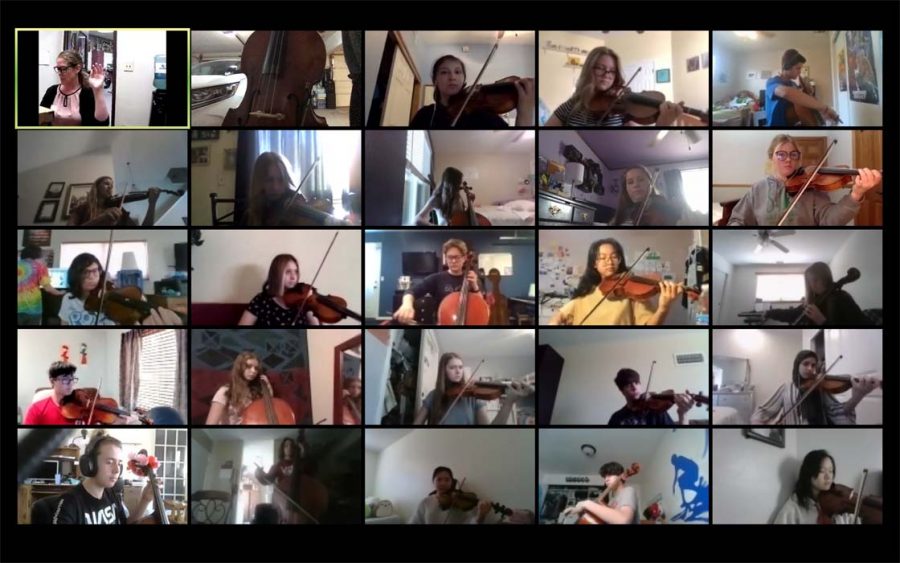Hands-on classes face added challenges
Orchestra students practice during a Zoom call.
September 12, 2020
As students and teachers across Burroughs continue to adjust to the long-distance education prompted by the COVID-19 pandemic, the learning curve has been steepest for those in hands-on courses, where classroom conditions are nearly impossible to simulate via email or Zoom.
Students who more inclined and successful learning with their hands are now working remotely via distance learning and in ways they couldn’t have imagined a few months ago.
“I miss being able to see my friends in person, and most of all being able to communicate with my teachers and craft materials with hands-on interaction,” said sophomore Lacey Jimenez.
The trick for teachers has been to adapt to this very different way of teaching and to find ways that keep the learning going — and relatable — despite the distance. Many teachers feel they are finding their way by being innovative in their approach.
“I am able to really focus on delivering meaningful content in my classes,” said art teacher Holly Hodgson. “I think the distance learning art curriculum and projects I am developing are accessible and adaptable to all students: they can find all the information they need to understand and practice the concepts and techniques and work at their own pace. There are so many great virtual art resources to find and incorporate into lessons and projects!”
Students in art classes received a suggested supply list with everything they needed to complete the projects virtually. Teachers have also turned to art history lessons to further strengthen their standards-based curriculum.
Amber Petersen, Burroughs new music teacher, has her own unique set of challenges.
“Without the ability to work together without latency issues, we are trying our best to focus on what is achievable within the DL setting,” said Petersen, who is teaching band, orchestra and choir classes remotely. The student musicians are focusing on listening, score analysis, guided solo practice, and small ensemble work in break-out rooms as a new way sharpening their skills and honing their talents.
To bridge the gap between in-person and virtual learning, musicians are using a new online modality called SmartMusic, which allows students to listen to the other parts of the ensemble and the accompaniment as Petersen conducts and students play along.
Still, adapting is taking some effort.
“Orchestra has always been a class which I could come to for a mental break and a place to relax my focus on my music, but online learning has made it more difficult to work on new pieces without the rest of the orchestra, making the timing quite tricky and hard to learn the music,” said senior Ellie Tsang.
Career Technical Education classes have also found creative ways to adapt to online lessons and idea-sharing. Projects are being implemented online for students to actively participate and learn via computer.
Although technology can be a part of an online curriculum, students and teachers recognize the challenges.
“I think technology can be very good but will never replace human interaction,” said CTE teacher Damien Jacotin.
Students without this interaction are still actively coming up with new ideas to have the same in-school experience.
“I have to take more time to learn on my own as well as in class in order to fully understand what to do,” said senior Beth Hibbs, who is taking ceramics virtually. “Despite the challenges of not being able to mold clay, I am still motivated to come up with new ideas to learn my techniques virtually.”
Despite the inability to work on their projects at school, the Wood and Metal Shop students are learning basic techniques with live and video instruction through Zoom and Canvas.
One common reaction heard repeatedly among teachers and students is the desire to get back to work in person when it is safe to do so.
“Hopefully we will be out of this sooner or later,” said Metal Shop teacher Sam Thompson. “If you’d told me last March that we would still be doing this in late August, I would’ve laughed. I’m not laughing!”

